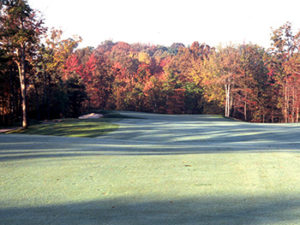In 1987, the Little Blue River flooded the town of English in south-central Indiana for the last time. All 614 residents of the town were relocated, leaving behind abandoned buildings filled with generations of memories and local history. But the love of the place runs deep in this rural community 45 minutes north of Louisville, and old time residents could not simply allow the land to become overgrown flood plain.
| Project name: | Old English Golf Course |
| Location: | English, Indiana |
| Description: | 18-hole, Par 72; practice facilities and three practice holes included |
| Maintenance Budget: | $400,000 (est.) |
| Construction Budget: | $1.2 million |
 The total golf course project will be an 18-hole, par 72 golf course with full-service practice facilities, short game center, and a three-hole First Tee course. The tees and greens average 6,000 sq. ft. in size, greens are California construction with L-93 bentgrass, a fully automatic irrigation system, and improved bluegrass fairways. The total construction budget was approximately $1.2 million dollars. This included renovation of an old house to serve as a clubhouse, and construction of the parking lot. Mark and Cary seemingly did the impossible when in reality they were just orchestrating a community effort.
The total golf course project will be an 18-hole, par 72 golf course with full-service practice facilities, short game center, and a three-hole First Tee course. The tees and greens average 6,000 sq. ft. in size, greens are California construction with L-93 bentgrass, a fully automatic irrigation system, and improved bluegrass fairways. The total construction budget was approximately $1.2 million dollars. This included renovation of an old house to serve as a clubhouse, and construction of the parking lot. Mark and Cary seemingly did the impossible when in reality they were just orchestrating a community effort.
A local construction company agreed to move the earth at a low cost when between jobs. However, the company got so caught up in the excitement of building Old English, they dedicated one crew fulltime to it. A couple of local golf course shapers signed on at a reduced rate, and rental equipment was placed on-site for operators who would donate their time to help build the course. Suppliers of materials and equipment supported the effort by providing excess goods at a discount price, and ASGCA member David Whelchel did all of the design work for travel expenses. It was like an old-time barn raising translated to a golf course.
The golf course had been the subject of many articles even before construction began, which helped generate the support it now enjoys.
Editors note: The above practical golf case study is an excerpt from “Building a Practical Golf Facility — A Step-by-step Guide to Realizing a Dream” published by the American Society of Golf Course Architects in 2005 and written by Dr. Michael J. Hurdzan, ASGCA.
